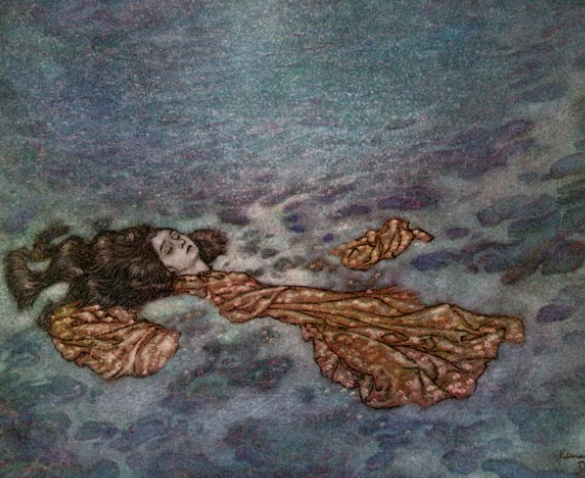The following is a prose piece by Christian Student Uniting member Hannah Roux.
In stories about selkies, possessing the selkie’s skin grants you power over them. The selkie-bride, captured or sometimes willingly married, wishes to return home: but where is her skin? Or, in another version of the story, she has hidden the skin – her true nature, herself – ready for an escape. Returning home one day, her husband finds her gone, vanished into the sea. Sometimes she takes their children with her.
What does “skin” mean here? “Skin” is an outer layer, so it might suggest something we put on and off – something that is not an essential part of who we are. But skin is also what the selkie wears to become who they really are; they take it off to walk on land, but human is not what they are. Their skin is their real self.
We say, sometimes, that someone is self-possessed, or comfortable in their skin. I think we mean that the distance between their inner life and their outer is smaller. It is more apparent who they really are because who they really are is close to the surface. Their skin fits them. But how can we tell if someone’s insides fit their outsides? Only by looking at the outsides. Without the outside, how could we see anything?
In Disney’s The Little Mermaid, Ariel desires transformation. She has always wanted to live on land; the prince is only an excuse to get there. It is the same in the Hans Christian Anderson version: the mermaid lacks a soul, and she wants to use the prince to get it. She is promised that if she can get the prince to love her, this will grant her one. The prince in this version is a means to an end. He never does love the mermaid, and so she dies. But, at the end of the story, the angels take pity on her, and send her to purgatory to earn the soul she desires. This is puzzling. “Purgatory” means to purge. To strip away your skin. But the skin is, in some sense, the real thing. What is a soul if not that act of desiring, if not saying, “I want to be who I really am”? And now, transformed, “I am who I was already.”
In both stories, the question is: do I fit in my skin? The mermaid’s skin does not fit her; she needs transformation. The selkie’s skin fits them; it is being on land that is painful. But their desire to be on land, that is also a real thing. Perhaps, like Ariel, some selkies really desire human skin. Perhaps this is what all shifting stories are about. The desire to fit something. To be made fitting: for the world, for one another, for the self. It is this restlessness, this change, that seems so human.
Another word for “skin” might be “form.” In literary studies, there are controversies about form and content. Is the form of the text the real thing? Or is it, rather, the content? Outside or inside? The form, in some sense, creates the content. What is the character “Mrs Bennet” without the words “Mrs Bennet”? But the content is what the words make us see. This is like seeing like a businessman in a smart suit. Would you see the businessman without the suit? Or just the naked man? But which is the real thing: the businessman or his suit? This is a theory of performance: we wear clothes to shape us. But this metaphor doesn’t suggest much stability. Clothes are temporary.
The word “skin” suggests something more like the form of a river. Though water pushes, broiling at the banks, the river stays the same. It is the shape of the river that gives it its name, not the water it contains. There is a Greek epigram: “You can never cross the same river twice.” What it really means is: the river’s water is always changed and exchanged. The shape of the river is the same; but its contents have changed. Rivers fall, reliably, in the same places, imprint and carve out homes in valleys – though they are always moving. It is their movement that makes them stay.
Whether the changing contents of the river change its essential identity is a question philosophy asks. The thought experiment goes like this. You own a boat. Over the years, the sail, the deck, the rudder – all need replacing. After seven years of this, every part has been changed. Is the boat still the same? Imagine the cells of your body: over seven years, one by one, all of them have been replaced, until – one bright morning, without even noticing – you are, suddenly, a new person.
You can, of course, cross the same river twice. The river will be, reliably, where you left it. Your mind roams in dreaming, but in the morning your body is still the same old body. Going down to the docks, you will see the same old boat there, though every part is new. Going down to the river, you will see the same old river, though filled with new water.
But even the shape of the river will change someday – like the water, though too slow to see. Even the shape of the body. Incredibly slow change might feel like stability. Perhaps this is the flux, or flow: the movement in time which feels like stillness.
***
The shape of the river is the river’s skin. The form of the river gives the river its name. The Christian tradition is full of stories about identity. Blessed by God, Abraham gains a new name. For wrestling with God, Jacob is called Israel. He carries away a scar: a twist on his hip, a mark on his body. Stories about baptism and conversion are also stories about identity. Paul says we take off our old self and put on our new. C.S. Lewis wrote, about his conversion, that he felt like a creature in a hard shell, being slowly peeled open.
Lewis returns to this image in part of his Voyage of the Dawn Treader. A boy has been turned into a dragon. The dragon-skin is the expression of who the boy is, his sin; his transformation, begun on the inside and spread out to the rest of him. The next transformation must start the same way: on the inside. He tries to make up for his sin, even while he is still a dragon. But on his own, he can’t be human again. The Lion (Christ) comes down to help him. Stripped of his skin (a painful process) and thrown into the well-water (baptism), the boy emerges a new person. It seems that the river has completely changed its course. And yet – here is the complication – this is the boy’s own skin. It is as if the river, flowing wrong, had been adjusted to its correct direction. The dragon skin never really fit him; he is now his real self. This is an allegory. Sin is our false self. But where does true self end and false begin?
This is the problem: we need a skin. And who is to say that someone else’s skin is wrong for them? We are often tempted to do this. We tell other people who they are meant to be. Some Christians talk about God’s design for gender and tell you that women are happier in traditional marriages. Or they ask, “Why are you putting your identity somewhere other than in Christ?” This is a question for queer people, because we use words to shape our skin.
In July 2021, the General Assembly of the Presbyterian Church in America voted to ban the ordination of anyone who calls themselves “gay” or “same-sex attracted.” A Christian who calls themselves “gay,” the new Overture 23 states, “undermines or contradicts their identity as new creations in Christ.” When I was in the evangelical church, this kind of position had, in retrospect, already begun to take shape. We should “love the sinner hate the sin,” my bible-study leader told us. “Sin,” this maxim implied, cannot be a true part of the sinner. It is something someone sheds, like a snake its skin. A queer sexuality cannot be the Christian’s true identity. The wrong self-naming becomes, in this view, idolatry. Idolatry puts the self above God’s plan for you. In Paul’s formulation, this means to put the false self above the true.
In one of my favourite Leonard Cohen songs, “Treaty,” he sings, huskily: “I heard the snake was baffled by his sin/ He shed his scales to find the snake within/ But born again, is born without a skin/ The poison enters into everything.”
Baffled is a good word here. And the implied question: what is the snake’s sin? Is it his very identity, “the snake within”? How can he rid himself of that by shedding skin? “Sin” and “skin” rhyme, as if related things. And then the surprise: without the skin, the poison enters in. This is the unavoidable vulnerability of religious community. How do we trust that our self-examination, our openness to being born again (and again and again), won’t let the poison in?
The Presbyterian Church’s policy is directed at gay Christians who practice celibacy. It is designed simply to prevent them from calling themselves “gay Christians.” It is, whatever else it is, a policy that understands the importance of naming. We use names to find each other, to share experiences, to access support and community. The name is important, like skin is important. It says: “I am really here,” and “I am who I am.” It is the shape and name of the river that help us find it again. Without its shape, the river is formless water. It is a person’s skin that lets us see them.
***
I must have learnt the word bisexual at some point while I was in high school. I don’t remember exactly when or how. But I remember thinking I already knew what it meant when, in my final year of school, a friend managed by some miracle to get permission to talk to our grade about diverse sexualities and genders. I had never thought of it as a word that might apply to me. Not even when I was writing my friend sappy love poetry. Not even when gripped with a half-understood jealousy when she talked about her boyfriend. I remember feeling uncomfortable, crouched down in my skin. I didn’t understand it. Someone else might have thought more closely, but I don’t remember thinking about words, then. It is because I remember this that I say that without its shape, the river is formless water.
I had other crushes. I called what I’d felt for my friend my first crush, but I didn’t call myself bisexual. I began to read queer romance novels obsessively, but when anyone asked me about what I was reading I kept pronouns ambiguous. At some point that year, I came across the word “demisexual” in one of them and googled it. A few months later, another romance novel featured a demi-sexual main character. When I got to the end, I went straight back to the beginning and read it over again.
Sometimes, these are the words that most seem to fit my skin. They felt like recognition: this is who I was already. But I am still learning how the words fit me. I have heard labels called a box or human sexuality called fluid. Why would you box yourself in? But for me, the words are an anchor. Reading that book, inhabiting that character, felt like filling in my skin. Knowing the shape of the river helps you find the water.
About half a year after I first started using the word demisexual, I was talking to someone about the sex appeal of the leading man of Bridgerton and they asked me if I ever used that word to describe myself. I said I sometimes did. I felt they had seen me.
I have talked to others who can’t see the point of labels like this. They can see why the LGBT part of the acronym is needed, but why all the other bits? Aren’t individuals all unique? What’s the point of using a word so obscure that no-one outside the queer community understands it? What’s the point of the long, infinitely regressing list: LGBTQIA+?
People talk about bi-invisibility: the absence of people who are visibly like you. This absence becomes self-fulfilling. We cannot see anyone like us, and so we are less visible, even to ourselves. What I mean by growing into your skin would be the opposite of this: the inside close to, and acknowledged by, the outside. This is not something anyone can do on their own. I think that if I could get up the courage to say more about the words I like to use to describe myself I would tell say something like this. The act of naming changes the shape of my skin, and this is a good thing. There really are skins that are wrong for me. I really do have a true and false identity. I want my skin to fit me.
***
Our identities are not simply individual. There are the questions of community. Who gets to tell you what skin you need to shed, and what is really you? How much does it matter if someone doesn’t understand the skin that’s you? In Lewis’s story about the boy turned dragon, the boy needs help to shed his dragon-skin. He needs to trust the lion to transform him. To lie on his back, expose his belly and let the lion dig into his skin. To trust that this will hurt him only briefly. In this story, the lion is Aslan, is God, and he, more than anyone, knows what the boy’s true shape is. But it is not always so clear who speaks God into our lives. Who should we listen to? When we ask the question “where does my self end and my sin begin?” we also need to ask, “who do I trust inside my skin?”
For me, this is the painful dimension. I believe in transformation. That no-one can enter the kingdom of God unless they have been born again. In Christ, I am a new creation. I have entered the water of baptism. I want to be challenged to change by a sermon. I want to repent of my sins. But I don’t trust the church to know what part of me is sin, and what part is my real skin.
The selkie takes off her skin, goes onto the land, and starts a family. She is trying out humanity. But she needs to trust the man not to trick her, to give her skin back if she should want to return. And if she does not trust him? She tricks him: on with the skin, into the water. If she still has her skin. Perhaps, if she had told him who she really was, he would not have believed her. Possessing someone’s skin grants you power over them. The boy trusts the lion to strip off his false skin, and not to kill the real him. In some stories, the selkie gives up their skin as a romantic gesture. The gesture says: I trust you not to hurt me. Such daring, to say: I trust you with my true self. In some stories, the skin is stolen. In some stories, the selkie cannot live long without the water.
Hannah Roux is a PhD student at the University of Sydney and a member of Christian Students Uniting.














2 thoughts on “Skin”
Wow. This is incredible. I had chills reading this. I relate really strongly to this part:
“I believe in transformation. That no-one can enter the kingdom of God unless they have been born again. In Christ, I am a new creation. I have entered the water of baptism. I want to be challenged to change by a sermon. I want to repent of my sins. But I don’t trust the church to know what part of me is sin, and what part is my real skin.”
Wow, this is just so beautiful. The way you’ve brought all of these ideas and stories together to give shape to your own personal story is so powerful.